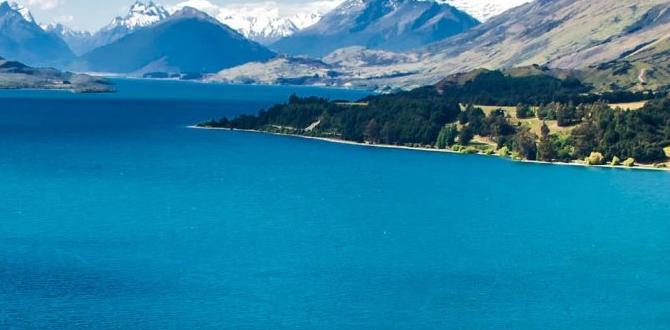Discover Arches National Park’s best-kept secrets with this essential guide to hidden gems. Explore less-crowded trails and unique formations beyond the famous arches for a more peaceful and memorable experience.
Arches National Park is a wonderland of sandstone marvels, drawing millions each year. While icons like Delicate Arch and Landscape Arch are breathtaking, the park’s true magic often lies just off the beaten path. Navigating Arches can feel overwhelming, especially when you want to escape the crowds and find those special, less-obvious spots.
This guide is here to help! We’ll reveal Arches National Park hidden gems, offering you a more intimate and unforgettable adventure. Get ready to discover breathtaking beauty without the usual hustle and bustle.
Why Seek Out Arches National Park Hidden Gems?
The popularity of Arches National Park is undeniable. Its dramatic crimson arches and unique geological features are world-renowned. However, this popularity means some of the most accessible and well-known spots can become very crowded, especially during peak season. Imagine arriving at a viewpoint only to find it packed, making it difficult to get that perfect photo or simply enjoy a moment of quiet contemplation.
Seeking out hidden gems offers several fantastic benefits:
Peace and Quiet: Enjoy the natural beauty without the constant buzz of crowds.
Unique Experiences: Discover formations and vistas few visitors ever see.
Better Photography Opportunities: Capture stunning shots without a sea of people in the background.
A Deeper Connection with Nature: Immerse yourself in the solitude and vastness of the desert landscape.
Sense of Discovery: The thrill of finding your own special spot in the park is incredibly rewarding.
This guide will equip you with the knowledge to find these treasures, making your Arches adventure truly your own.
Planning Your Arches Escape: Essential Tips
Before we dive into the hidden gems, a little planning goes a long way for a stress-free trip. Remember, Arches is in a desert environment, so preparation is key.
Best Time to Visit
While hidden gems can be enjoyed year-round, consider the weather.
Spring (April-May) and Fall (September-October): These are generally the most pleasant times. Temperatures are mild, perfect for hiking. However, these are also the busiest seasons. Your strategy for finding hidden gems is even more important!
Summer (June-August): Expect very hot temperatures, especially midday. Early morning and late evening hikes are essential. Bring plenty of water!
Winter (November-March): Cooler temperatures, fewer crowds, and the possibility of snow dusting the red rocks offer a unique, serene experience. Some services might be limited.
Park Entrance and Timed Entry
Arches National Park often implements a timed entry reservation system during peak months. This helps manage crowd levels. Always check the official Arches National Park website for the most up-to-date information on reservations, entrance fees, and operating hours before your visit. Having your timed entry reservation booked in advance is crucial for smooth entry.
What to Pack for Comfort and Safety
Comfort and safety are paramount, especially when exploring less-trafficked areas.
Water: Carry more than you think you’ll need. Dehydration is a serious risk. Consider a hydration pack or multiple water bottles.
Sun Protection: A wide-brimmed hat, sunglasses, and high SPF sunscreen are non-negotiable.
Sturdy Footwear: Hiking boots or sturdy athletic shoes with good grip are essential for uneven terrain.
Layers of Clothing: Desert temperatures can fluctuate dramatically. Pack light, breathable layers, including a jacket or fleece for cooler mornings and evenings.
Snacks: High-energy snacks like trail mix, energy bars, and fruit will keep you going.
First-Aid Kit: A basic kit for minor injuries is always wise.
Navigation Tools: While trails are marked, a park map or a GPS device can be helpful, especially for less-developed areas.
Headlamp or Flashlight: If you plan on sunset or sunrise hikes, a light source is vital.
Comfort Items: For longer excursions, things like travel-friendly cushions or discreet adult diapers can offer added comfort and confidence, especially for longer hikes or if unexpected bathroom breaks are a concern in remote areas. Knowing you have reliable incontinence products can significantly reduce travel anxiety.
Arches National Park Hidden Gems: Your Essential Guide
Now, let’s explore some of the less-trodden paths and overlooked wonders of Arches! These spots offer incredible beauty and a more tranquil experience.
1. Fiery Furnace: A Labyrinth to Explore
While not entirely “hidden” as it requires a permit or a ranger-led tour, the Fiery Furnace is a magnificent labyrinth of sandstone fins, canyons, and arches that most visitors miss. It feels worlds away from the paved viewpoints.
What it is: A narrow, maze-like canyon system with incredibly intricate formations.
Why visit: The challenge of navigating the maze, the unique close-up views of sandstone erosion, and the solitude (especially on a self-guided permit).
How to access:
Ranger-Led Tours: Highly recommended for first-timers. These guided walks offer safety and insights into the geology and ecology. Book well in advance!
Self-Guided Permits: For experienced hikers comfortable with navigation. These are limited and require a day-before reservation. You’ll need to study a map and be adept at route-finding.
Tips: Wear sturdy shoes, carry plenty of water, and be prepared for some scrambling. It’s easy to get disoriented, so stay aware of your surroundings.
2. Tower Arch: A Striking Example Off the Beaten Path
Located in the northern, less-visited part of the park, Tower Arch is a magnificent, freestanding arch that resembles a castle tower. The drive to the trailhead is on a dirt road, which naturally deters many visitors.
What it is: A large, impressive arch set against a dramatic backdrop.
Why visit: Fewer crowds, a sense of remoteness, and stunning views that feel like a personal discovery.
How to access: The trailhead is accessible via the Klondike Bluffs Road, a backcountry dirt road. A high-clearance vehicle is recommended, though a regular car can often manage in good conditions. The hike to the arch is about 2.5 miles roundtrip and moderately strenuous.
Tips: Check road conditions with the park service before heading out. The hike involves some sandy sections and a bit of scrambling over slickrock.
3. Klondike Bluffs Trails: Sandstone Wonders Abound
The Klondike Bluffs area itself is a jackpot for those looking to explore beyond the main scenic drive. Beyond Tower Arch, you’ll find other fascinating arches and formations.
What it is: A region with multiple hiking trails leading to various arches and unique geological features like fins and hoodoos.
Why visit: Offers a variety of hikes from easy to moderate, with the reward of seeing numerous arches without the typical crowds.
Key trails:
Lower Klondike Bluffs Trail: Leads to the impressive Klondike Arches.
Two Eagles Trail: A nice loop offering diverse scenery.
How to access: Via the Klondike Bluffs Road, the same access as Tower Arch.
Tips: This area can be exposed to sun and wind. Pack accordingly. Bring a map and be prepared for sandy trails.
4. Pritchett Canyon: A Rugged Adventure for the Determined
Pritchett Canyon is a more challenging, backcountry hike that offers a true sense of expedition and the reward of some of the park’s most spectacular, less-seen arches, including Pritchett Arch and the massive, often unseen, Double Arch. (Note: This isn’t the easily accessible Double Arch in the Windows section.)
What it is: A long, rugged canyon hike requiring excellent stamina and navigation skills.
Why visit: For the adventurous soul seeking solitude, a physical challenge, and the chance to see massive, awe-inspiring arches in a wild setting. It’s a true exploration.
How to access: The trailhead is located off the park’s scenic drive in the southern section. The hike is approximately 6-8 miles roundtrip and involves significant boulder scrambling, creek bed walking, and route-finding.
Tips: This hike is for experienced hikers only. You must carry ample water, wear sturdy footwear, and have a good topographical map. It’s easy to get lost. Check with rangers for current conditions.
5. False Kiva: A Contemplative Alcove
False Kiva is a large, sandstone alcove that resembles a kiva (a ceremonial chamber of the Pueblo people), though it is a natural formation. Its allure is its subtle presence and the contemplative atmosphere it offers.
What it is: A large, semi-circular alcove carved into a sandstone cliff.
Why visit: Offers a unique, geological “room with a view” in a quieter part of the park. It feels like stepping into a secret sanctuary.
How to access: The trail to False Kiva is short (about 1 mile roundtrip) but unmarked and unofficial, starting from the Klondike Bluffs road. It is crucial to obtain directions from a park ranger or reliable local source, and to practice Leave No Trace principles diligently as this is a sensitive area.
Tips: Respect the fragile environment. Do not climb on the formations, and stay on established paths where possible to minimize impact.
6. North and South Window Section Detours
While The Windows section itself is popular, few venture to the less-photographed but equally beautiful areas just beyond the main viewpoints.
What it is: Undiscovered alcoves and smaller arches around the perimeter of the main Windows area.
Why visit: You can often find quiet spots for reflection and excellent photographic angles of the larger formations that people miss.
How to access: Explore the trails that skirt the main viewpoints or venture slightly off the designated paths (where permitted and safe) to look for smaller, less obvious features. Always stay on designated trails if unsure.
Tips: Look up and around! Sometimes the most interesting features are not directly in front of you.
Beyond the Arches: Experiencing the Arches Landscape
The beauty of Arches isn’t solely about the named arches. It’s about the vast, sculpted desert landscape.
Sandstone Fins and Slickrock
The park is characterized by countless sandstone fins – tall, thin walls of rock that have been eroded by wind and water. Venturing onto the slickrock, the smooth, undulating sandstone surfaces, can lead to unexpected discoveries.
Tips for exploring slickrock:
Wear shoes with excellent grip.
Be aware of your footing; it can be slippery when wet or sandy.
Look for the subtle patterns and textures created by erosion.
Explore areas with less obvious trails – the smooth surfaces beckon exploration, but always stay aware of your surroundings and where you’re going.
Desert Wildlife and Flora
Even in these rugged landscapes, life persists. Keep an eye out for:
Desert Bighorn Sheep: Often seen on the rocky slopes early in the morning or late in the evening.
Mule Deer: Common throughout the park.
Reptiles: Lizards darting across the rocks.
* Cacti and Desert Wildflowers: Particularly vibrant in spring after good rain.
Remember to admire wildlife from a distance and never feed them. Their survival depends on their natural environment.
Table: Arches National Park Hidden Gem Quick Reference
Here’s a quick look at our recommended hidden gems, their difficulty, and why you should seek them out.
| Gem Name | Difficulty | Key Features | Best For | Access Notes |
| Fiery Furnace | Moderate to Strenuous | Maze-like canyons, intricate formations | Adventure, unique geology | Permit or Ranger Tour required. Book ahead. |
| Tower Arch | Moderate | Large, tower-like arch, remote feel | Solitude, impressive arch | Dirt road access (Klondike Bluffs Rd), recommend high-clearance vehicle. |
| Klondike Bluffs | Easy to Moderate | Multiple arches, fins, diverse trails | Variety, fewer crowds, scenic beauty | Klondike Bluffs Rd access. Sandy trails. |
| Pritchett Canyon | Strenuous | Massive arches, rugged canyon, challenging hike | Serious hikers, adventure, solitude | Backcountry hike, requires navigation skills, ample water, and stamina. |
| False Kiva | Easy (but unmarked) | Natural sandstone alcove, peaceful atmosphere | Serenity, unique geological structure | Unmarked, requires careful navigation and permit/ranger advice. Respect LNT. |
| Windows Detours | Easy to Moderate | Smaller alcoves, unique photo angles, quiet spots | Photography, quiet reflection | Explore around main Windows area, stay on trails or with clear visibility points. |
FAQs
Q1: How do I get a permit for Fiery Furnace?
You can get a self-guided permit up to 24 hours in advance at the Arches Visitor Center on a first-come, first-served basis. Ranger-led tours are also available and highly recommended for first-timers; these need to be booked well in advance online.
Q2: Are the hidden gems safe for solo travelers?
Many hidden gems can be safely explored by solo travelers, especially those with well-marked trails like Tower Arch or parts of Klondike Bluffs. However, for more challenging hikes like Pritchett Canyon or Fiery Furnace, hiking with a companion or joining a ranger tour is strongly advised due to navigation and terrain risks.
Q3: What are the biggest risks when hiking in Arches National Park?
The primary risks are dehydration and heatstroke, especially during warmer months. Other risks include flash floods, falling rocks, getting lost (particularly on unmarked trails), and sprains or breaks due to uneven terrain. Always be prepared, hike within your limits, and inform someone of your plans.
Q4: Can I explore Arches independently without a guide?
Yes, for most areas. The main scenic drive and its associated popular trails are designed for independent exploration. For Fiery Furnace, you need either a permit or to join a ranger tour. Unmarked trails require caution and good navigation skills. Always check park regulations.
Q5: What kind of shoes do I need for Arches?
Sturdy hiking boots or trail shoes with good ankle support and excellent grip are highly recommended, especially if you plan to explore any slickrock or uneven terrain. Regular athletic shoes might suffice for very short, paved walks but aren’t ideal for most trails.
Q6: How much water should I carry?
For any hike longer than an hour, carry at least 1 liter of water per person per hour. In hot weather or for strenuous hikes, carry even more. It’s better to have too much water than not enough. A hydration reservoir (like a CamelBak) is a convenient option.
Q7: What if I have incontinence issues while traveling?
Traveling with incontinence is manageable with the right preparation. Products like discreet adult diapers or protective underwear offer security and confidence, allowing you to focus on your adventure. Ensure you pack enough for your trip, plus a few extra, and carry a small bag for discreet disposal of used products when away from facilities. Many modern adult incontinence products are highly absorbent, odor-controlling, and comfortable for all-day wear, making them ideal for hiking and long days exploring.






